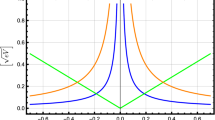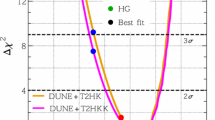Abstract
An attempt has been made to discriminate theoretically the three possible patterns of neutrino mass models,viz., degenerate, inverted hierarchical and normal hierachical models, within the framework of Type-II see-saw formula. From detailed numerical analysis we are able to arrive at a conclusion that the inverted hierarchical model with the same CP phase (referred to as Type [IIA]), appears to be most favourable to survive in nature (and hence most stable), with the normal hierarchical model (Type [III]) and inverted hierarchical model with opposite CP phase (Type [IIB]), follow next. The degenerate models (Types [IA,IB,IC]) are found to be most unstable. The neutrino mass matrices which are obtained using the usual canonical see-saw formula (Type I), and which also give almost good predictions of neutrino masses and mixings consistent with the latest neutrino oscillation data, are re-examined in the presence of the left-handed Higgs triplet within the framework of non-canonical see-saw formula (Type II). We then estimate a parameter (the so-called discriminator) which may represent the minimum degree of suppression of the extra term arising from the presence of left-handed Higgs triplet, so as to restore the good predictions on neutrino masses and mixings already acquired in Type-I see-saw model. The neutrino mass model is said to be favourable and hence stable when its canonical see-saw term dominates over the non-canonical (perturbative) term, and this condition is used here as a criterion for discriminating neutrino mass models.
Similar content being viewed by others
References
M Maltoni, T Schwetz, M A Tortola and J W F Valle,New J. Phys. 6, 122 (2004), hep-ph/0405172
A Yu Smirnov, hep-ph/0402264
G Altarelli and F Feruglio,New J. Phys. 6, 106 (2004), hep-ph/0405048
John B Bahcall, M C Gonzalez-Garcia and Carlos Pena-Garay,J. High Energy Phys. 0408, 016 (2004), hep-ph/0406294
A Bandyopadhyay, S Choubey, S Goswami, S T Petcov and D P Roy,Phys. Lett. B608, 115 (2005), hep-ph/0406328
Carl H Albright,Phys. Lett. B599, 285 (2004), hep-ph/0407155
D Indumati and M V N Murthy,Phys. Rev. D71, 013001 (2005), hep-ph/0407336
S Palomares-Ruiz and S T Petcov,Nucl. Phys. B712, 392 (2005), hep-ph/0406096 Raj Gandh, Pomita Ghoshal, S Goswami, P Mehta and S Uma Sankar, hep-ph/ 0506145
S Choubey and W Rodejohann,Phys. Rev. D72, 033016 (2005), hep-ph/0506102
Super-Kamiokande Collaboration: S Fukudaet al, Phys. Lett. B539, 179 (2002), hep-ex/9807003
SNO Collaboration: S N Ahmedet al, Phys. Rev. Lett. 92, 181301 (2004), nuclex/0309004
Super-Kamiokande Collaboration: Y Fukudaet al, Phys. Rev. Lett. 81, 1562 (1998), hep-ex/9807003
KamLAND Collaboration: K Eguchiet al, Phys. Rev. Lett. 90, 021802 (2003), hep-ex/0212021
CHOOZ Collaboration: M Apollonioet al, Phys. Lett. B466, 415 (1999), hep-ex/9907037
K2K Collaboration: M H Ahnet al, Phys. Rev. Lett. 90, 041801 (2003), hep-ex/0212007
LSND Collaboration: A Aguilaret al, Phys. Rev. D64, 112007 (2001), hep-ex/0104049
BooNE Collaboration: E D Zimmerman,Nucl. Phys. Proc. Suppl. 123, 267 (2003), hep-ex/0211039
WMAP Collaboration: C L Bennettet al, Astrophys. J. Suppl. 148, 1 (2003)
D N Spergelet al, Astrophys. J. Suppl. 148, 175 (2003)
A Kogutet al, Astrophys. J. Suppl. 148, 161 (2003)
G Hinshawet al, Astrophys. J. Suppl. 148, 135 (2003)
L Verdeet al, Astrophys. J. Suppl. 148, 195 (2003)
H V Peiriset al, Astrophys. J. Suppl. 148, 213 (2003)
S Hannestad,J. Cosmol. Astropart. Phys. 0305, 004 (2003)
O Elgaroy and O Lahav,J. Cosmol. Astropart. Phys. 0304, 004 (2003)
S Hannestad,Eur. Phys. J. C33, 5800 (2004), hep-ph/0310220
S Hannestad and G Raffelt,J. Cosmol. Astropart. Phys. 0404, 008 (2004), hep-ph/0312154
The Heidelberg-Moscow Collaboration: H V Klapdor-Kleingrothauset al, Euro. Phys. J. A12, 147 (2001)
C E Aalsethet al, Phys. Rev. D65, 092007 (2002), hep-ex/0202026
S M Bilenky, hep-ph/0403245
H V Klapdor-Kleingrothauset al, Mod. Phys. Lett. A37, 2409 (2001)
H V Klapdor-Kleingrothaus, A Dietz and I V Krivoshena,Phys. Lett. B586, 198 (2004)
In order to avoid possible confusion in nomenclature, types of neutrino mass models are denoted inside the square bracket e.g., Type [III], whereas types of see-saw formula are expressed without square bracket, e.g., Type I
G Altarelli and F Feruglio,Phys. Rep. 320, 295 (1999), hep-ph/9905536
M Gell-Mann, P Ramond and R Slansky, in: Supergravity,Proceedings of the Worshop, Stony Brook, New York, 1979, edited by P van Nieueenhuizen and D Freedman (North-Holland, Amsterdam, 1979)
T Yanagida,KEK Lectures 1979 (unpublished)
R N Mohapatra and G Senjanovic,Phys. Rev. Lett. 44, 912 (1980)
R N Mohapatra and G Senjanovic,Phys. Rev. D23, 165 (1981)
G Lazarides, Q Shafi and C Wetterich,Nucl. Phys. B181, 287 (1981)
C Watterich,Nucl. Phys. B187, 343 (1981)
B Brahmachari and R N Mohapatra,Phys. Rev. D58, 015001 (1998)
R N Mohapatra,Nucl. Phys. Proc. Suppl. 138, 257 (2005), hep-ph/0402035
Wei-Min Yang and Zhi-Gang Wang,Nucl. Phys. B707, 87 (2005), hep-ph/0406221 S Antush and S F King, hep-ph/0405093 Werner Rodejohann, hep-ph/0403236
Borut Bajc, Goran Senjanovic and Francesco Vissani,Phys. Rev. D70, 093002 (2004), hep-ph/0402140
Stefano Bertolini, Michell Frigerio and Michal Malinsky,Phys. Rev. D70, 095002 (2004), hep-ph/0406117
Thomas Hambye and Goran Senjanovic,Phys. Lett. B582, 73 (2004)
Narendra Sahu and S Uma Sankar,Phys. Rev. D71, 013006 (2005), hep-ph/0406065
Bhaskar Dutta, Yukihiro Mimura and R N Mohapatra,Phys. Lett. B603, 35 (2004), hep-ph/0406262
Type-III see-saw formula [21] involves introducing in addition to left- and right-handed neutrinos, three SO(10) singlet neutrinos. As a consequence, a mass term for a singlet field can effectively lead to a Majorana mass matrix for right-handed neutrinos, which finally gives to the left-handed Majorana mass term
Carl H Albright and S M Barr,Phys. Rev. D70, 033013 (2004), hep-ph/0404095
S M Barr,Phys. Rev. Lett. 92, 101601 (2004), hep-ph/0309152
A S Joshipura, E A Paschos and W Rodejohann,J. High Energy Phys. 0108, 029 (2001), hep-ph/0105175
Nucl. Phys. B611, 227 (2001), hep-ph/0104228
In some papersvu ~ 250 GeV is taken in place ofMW. We prefer here to take ~82 GeV as it is nearer to our input value of eithermt = 82.43 GeV ormΤ tan Β = 1.3 x 40 GeV in the text. In this way, both the terms of the Type-II see-saw formula have almost same value of weak scale. However, taking different values does not alter the conclusion of our analysis
R N Mohapatra,Nucl. Phys. Proc. Suppl. 138, 257 (2005), hep-ph/0402035; hep-ph/0306016
B Bajc, G Senjanovic and F Vissani, hep-ph/0402140
S Antusch and S F King,Nucl. Phys. B705, 239 (2005), hep-ph/0402121
S Antusch and S F King,Phys. Lett. B597, 199 (2004), hep-ph/0405093
W Rodejohann,Phys. Rev. D70, 073010 (2004), hep-ph/0403236
T Hambye and G Senjanovic,Phys. Lett. B582, 73 (2004), hep-ph/0307237
P O’Donnell and U Sarkar,Phys. Rev. D49, 2118 (1994)
K A Babu, B Dutta and R N Mohapatra,Phys. Rev. D67, 076006 (2003), hep-ph/0211068
Ernest Ma,Phys. Rev. D69, 011301 (2004), hep-ph/0308092
Utpal Sarkar,Phys. Lett. B594, 308 (2004), hep-ph/0403276
M K Parida, B Purkayastha, C R Das and B D Cajee,Eur. Phys. J. C28, 353 (2003), hep-ph/0210270
B Bajc, G Senjanovic and F Vissani,Phys. Rev. Lett. 90, 051802 (2003)
A Melfo and G Senjanovic,Phys. Rev. D68, 03501 (2003)
N Nimai Singh and M Patgiri,Int. J. Mod. Phys. A17, 3629 (2002)
M Patgiri and N Nimai Singh,Indian J. Phys. A76, 423 (2002)
M Patgiri and N Nimai Singh,Int. J. Mod. Phys. A18, 443 (2003)
For a discussion, see, I Dorsner and S M Barr,Nucl. Phys. B617, 493 (2001)
S M Barr and I Dorsner,Nucl. Phys. B585, 79 (2000)
E Kh Akhmedov, M Frigerio and A Yu Smirnov,J. High Energy Phys. 0309, 021 (2003), hep-ph/0305322
D Falcone,Phys. Lett. B479, 1 (2000), hep-ph/0204335
This is also true for any diagonal mLR with any arbitrary pair of (m,n). A corresponding Mrr can be found out in principle
H Murayama,Int. J. Mod. Phys. A17, 3403 (2002), hep-ph/02010022
A de Gouvea, A Friedland and H Murayama,Phys. Lett. B490, 125 (2000)
M Patgiri and N Nimai Singh,Phys. Lett. B567, 69 (2003)
S F King and N Nimai Singh,Nucl. Phys. B596, 81 (2001)
S F King and N Nimai Singh,Nucl. Phys. B591, 3 (2000)
Mrinal Kumar Das, Mahadev Patgiri and N Nimai Singh,Pramana J. Phys. 65, 995 (2005), hep-ph/0407185
K S Babu and S M Barr,Phys. Rev. Lett. 85, 1170 (2000)
H Murayama and C Pena-Garay,Phys. Rev. D69, 031301 (2004), hep-ph/0309114
Author information
Authors and Affiliations
Rights and permissions
About this article
Cite this article
Singh, N.N., Patgiri, M. & Das, M.K. Discriminating neutrino mass models using type-II see-saw formula. Pramana - J Phys 66, 361–375 (2006). https://doi.org/10.1007/BF02704390
Received:
Revised:
Accepted:
Issue Date:
DOI: https://doi.org/10.1007/BF02704390




